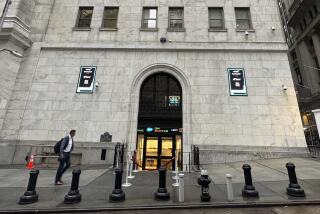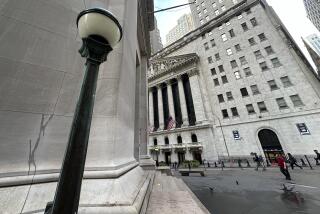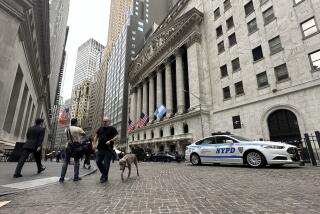Buying Frenzy Sends Dow Up 74 in 6th-Best Gain
Hopes of a temporary end to rising interest rates whipped what had been a moribund stock market into a furious buying frenzy on Tuesday, pushing the Dow Jones industrial average to its sixth-highest gain ever and triggering cautious predictions of further gains.
The widely watched average of blue-chip stocks, which had languished last week amid the slowest trading volume in months, exploded above the 2,000 level with a gain of 74.68 points, its best showing since Jan. 4.
The 3.8% advance, to 2,031.12, put the Dow at its highest level since May 4. New York Stock Exchange volume totaled 247.61 million shares, the busiest since Jan. 25. Many stocks participated in the rally, with gainers outnumbering losers on the Big Board by a nearly 4-1 margin and other market indexes also posting healthy advances.
The sharpness of Tuesday’s rally surprised analysts and traders, as it came without any major news developments. It also came after the NYSE imposed limits on computerized program trading in the final hour of trading.
Instead, experts said, the rally was triggered by a culmination of two factors: a possible end to recent rises in interest rates, reflected in a recent stabilizing in bond prices, and extreme pessimism among market analysts last week, which may have overly depressed stock prices and made a turnaround inevitable.
‘Long-Overdue Rally’
“This is the start of a long-overdue rally,” said Ralph Acampora, a market analyst at Kidder, Peabody & Co., who said stocks had become oversold last week.
However, he and other analysts cautioned that the market overall is still in a very precarious condition.
“As far as we know, this is still a bear market rally,” said A. Marshall Acuff Jr., portfolio strategist at Smith Barney, Harris Upham & Co. He said stocks are still high by historical standards. They will need a continued rally in bond prices--meaning lower interest rates--to sustain Tuesday’s advance, he added.
The outlook on interest rates improved, traders said, when the Federal Reserve Board late Friday did not raise its discount rate--its fee on loans to member banks--as had been expected. That was viewed as a sign that recent fears of higher interest rates might be exaggerated.
Commodity Prices Soar
That view was enhanced by gains in bond prices Tuesday, despite huge jumps in commodity prices as measured by the Commodity Research Bureau index. The widely watched index, viewed as an inflation measure, posted its biggest gain in nearly 7 1/2 years Tuesday as it rose to a three-year high. Bond prices tend to fall when investors fear higher interest rates and inflation.
Analysts said the market also was inspired by the dollar’s rise to a seven-month high against the West German mark. A rising currency could attract foreign investors to dollar-denominated assets.
Market watchers also attributed the rally to reaction to recent surveys showing that sentiment among investors and investment-newsletter editors had become unusually pessimistic in recent days.
Bearishness Positive
One survey, for example, showed 70% of newsletter editors expecting the market to fall in the short term. Analysts say that extreme bearishness actually is positive for stock prices, because it means that many investors have already sold stocks heavily and thus have a lot of cash ready to reinvest if conditions improve.
“There is a lot of cash in institutional hands,” said Smith Barney’s Acuff.
Traders say much of Tuesday’s buying came from pessimistic investors who had “sold short”--that is, bet on lower stock prices. These short-sellers had to buy stock in order to limit their losses should such price declines not materialize.
Capture Big Dividends
A great deal of buying--as much as 100 million shares by some estimates--also came from institutional investors using so-called “dividend capture” strategies under which they buy stocks that are about to pay large dividends. The three most active stocks Tuesday--Ohio Edison, Public Service Enterprise Group and Continental Corp.--alone accounted for 98.4 million shares traded. Each is about to pay giant dividends.
Analysts said they were surprised by the market’s continued strength into the last hour of trading Tuesday, as it came after the NYSE--for the third time ever--imposed a rule under which it asked traders to refrain from using its computerized order-execution system.
That rule, imposed if the Dow average rises or falls more than 50 points from its previous day’s close, is designed to discourage computerized program trading, which many analysts blame for exacerbating last October’s stock market crash. Program traders use the computerized order-execution system to speed completion of their trades.
However, program trading apparently continued even after the rule took effect, as the trades were executed manually through brokers on the NYSE floor.
Further Advances Seen
Analysts said the fact that Tuesday’s rally came with such high volume and with so many stocks participating could indicate further advances the rest of the week. Gaining issues on the NYSE totaled 1,211 versus 333 decliners and 401 stocks that remained unchanged.
More to Read
Inside the business of entertainment
The Wide Shot brings you news, analysis and insights on everything from streaming wars to production — and what it all means for the future.
You may occasionally receive promotional content from the Los Angeles Times.










